🧠 AP Psychology Unit 1: Biological Bases of Behavior
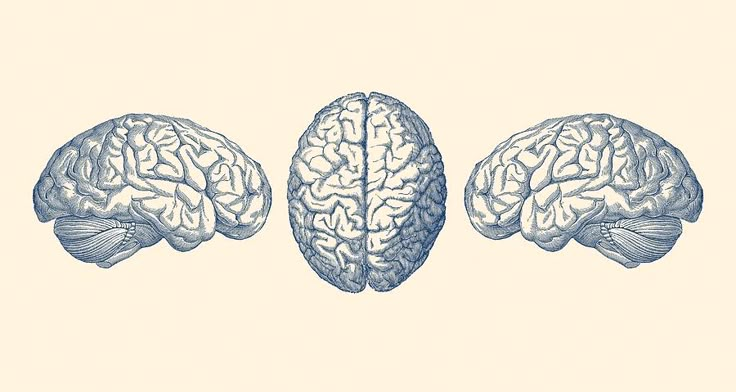
* definitions are from Myers 4th edition and some are from online
1.1: Interaction of Heredity and Environment
heredity (nature) - genetic characteristics passed down to us through biological ancestors
influences traits such as appearance, intelligence, and health predispositions
environment (nurture) - our surroundings/external factors we experience such as family interactions and education.
epigenetics - the study of how our environment and behaviors (like diet, stress, or sleep) can change the way our genes work w/o changing DNA
nature-nurture issue - longstanding controversy over the contribution that genes and environment have on our psychological traits and behaviors.
natural selection - principle that inherited traits enabling an organism to survive and reproduce in a particular environment will (in competition with other trait variations) most likely be passed on to succeeding generations.
evolutionary psychology - the study of the evolution of the behavior and mind; uses principles of natural selection and how it influences behavior for survival and reproduction
some theories misused evolution (eugenics) to justify discrimination
phrenology - outdated belief that the shape/bumps on our skull determines personality traits and mental abilities. (widely discredited but contributed to early explorations of brain functions)
twin studies help researchers understand how genes affect behaviors and mental processes
monozygotic twins (identical) - individuals who developed from a single fertilized egg that split into two
share same genetic material and exhibit similarities in traits and behaviors
dizygotic twins (fraternal) - individuals who developed from separate fertilized eggs.
share 50% of genetic makeup, similar to regular siblings
mutations - random error in gene replication
interaction - interplay that occurs when the effects of one factor (such as environment) depends on another factor (heredity)
genes - biochemical units of heredity
genome - common set of genes
behavior genetics - the study of the relative power and limits of genetic and environmental influences on behavior
1.2: Overview of the Nervous System
nervous system - the body’s speedy, electrochemical communication network consisting of all the nerve cells in peripheral and central nervous systems.
central nervous system - includes the brain and spinal cord, responsible for transmitting info throughout the body
peripheral nervous system - relays messages from the central nervous system to the rest of the body; connects CNS to limbs/organs, serves as communication relay between the brain and spinal cord and the rest of the body; includes autonomic and somatic nervous system
somatic nervous system - controls voluntary movements and enables sensations
autonomic nervous system - governs processes that are involuntary such as heartbeat, digestion, and respiratory rate. (includes parasympathetic and sympathetic nervous system)
parasympathetic nervous system - promotes a state of calm and relaxation, facilitating rest and digestion; slows heart rate; maintains homeostasis
sympathetic nervous system - prepares the body for “fight or flight” response in time of stress or danger, increases heart rate and redirects energy
nerves - bundles of axons (extensions of nerve cells) that form neural cables connections the CNS with muscles, glands, and sensory organs.
sensory neurons - neurons that carry info from sensory receptors (like skin, eyes, ears) to the CNS
responsible for transmitting sensory info such as touch, taste, smell, sight, and sound
motor neurons - neurons that carry signals from the CNS to muscles and glands.
responsible for voluntary + involuntary muscle movements, facilitating actions such as walking or reflex responses
interneurons - neurons within the brain and spinal cord; serve as a connecting point between sensory inputs and motor outputs
reflex - a simple, automatic response to a sensory stimulus
1.3: The Neuron and Neural Firing
neurons - a nerve cell; the basic building block of the nervous system.
cell body - the part of the neuron that contains the nucleus; the cell’s life support center.
dendrite - the neurons bushy branching extensions that receive and integrate messages, conducting impulses towards the cell body.
axon - the segmented neuron extension that passes messages through its branches to other neurons or to muscles or glands.
myelin sheath - a fatty tissue layer segmentally encasing the axons of some neurons; enables vastly greater transmission speed as neural impulses hop from one node to the next.
glial cells - cells in nervous system that support, nourish, and protect neurons; they may also play a role in learning, thinking, and memory.
action-potential - a neural impulse; a brief electrical charge that travels down an axon.
threshold - the level of stimulation required to trigger a neural impulse.
refractory period - a brief resting pause that occurs after a neuron has fired; subsequent action potentials cannot occur until the axon returns to its natural state.
all-or-none-response - a neurons reaction of either firing (w/ a full strength response) or not firing.
synapse - the junction between the axon tip of the sending neuron and the dendrite or cell body of the receiving neuron. tiny gap at this junction is called synaptic gap.
neurotransmitters - chemical messengers that cross the synaptic gaps b/n neurons. when released by sending neurons they travel across synapse and bind to receptor sites on the receiving neuron thereby influencing whether that neuron will generate a neural impulse.
reuptake - a neurotransmitter reabsorption by the sending neuron.
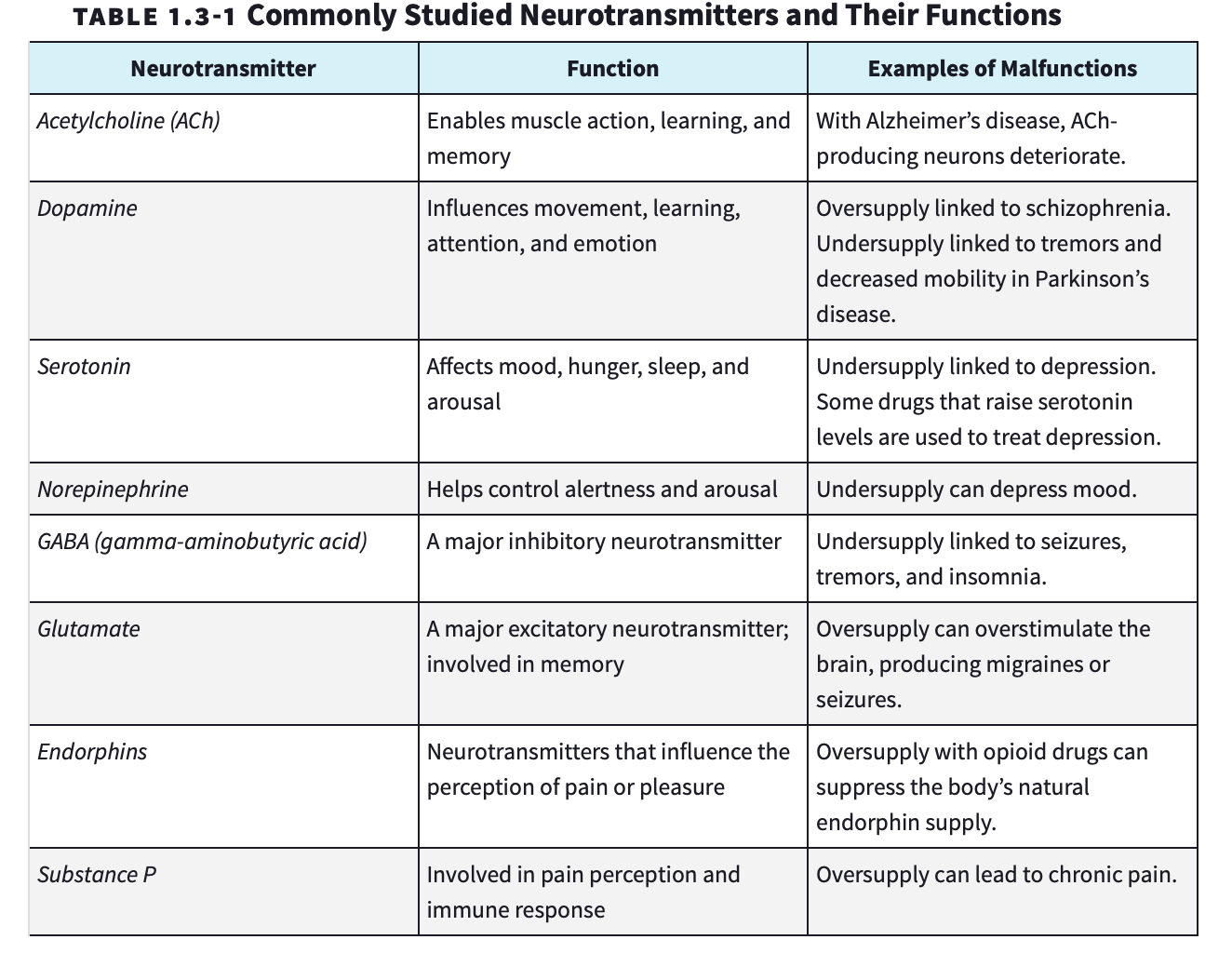
endorphins - natural, opioid-like neurotransmitters linked to pain control and pleasure.
agonist - a molecule that increases a neurotransmitters action
antagonist - a molecule that inhibits or blocks a neurotransmitters action
endocrine system - the body’s “slow” chemical communication system; a set of glands and fat tissue that secrete hormones into the bloodstream.
hormones - chemical messengers that are manufactured by the endocrine glands, travel through the bloodstream, and affect other tissues
psychoactive drugs - a chemical substance that alters the brain, causing changes in mood and perceptions.
substance use disorder - disorder characterized by continued substance use despite significant life disruption.
depressants - drugs that reduce neural activity and slow body functions.
barbiturate - drugs that depress central nervous system activity, reducing anxiety but impairing memory and judgement.
opioids - opium and its derivatives; they depress neural activity, temporarily lessening pain and anxiety
stimulants - drugs that excite neural activity and speed up body functions
hallucinogens - psychedelic (“mind-manifesting”) drugs that distort perceptions and evoke sensory images in the absence of sensory input.
near-death-experience - an altered state of consciousness after a close brush with death (such as cardiac arrest); often similar to drug induced hallucinations
1.4: The Brain
biological psychologists - scientific study of the links between biological (genetic, neural, hormonal) and psychological processes.
biopsychosocial approach - an integrated approach that incorporates biological, psychological, and social-cultural levels of analysis.
levels of analysis - the differing complementary views, from biological to psychological to social-cultural for analyzing any given phenomenon
neuroplasticity - the brains ability to change, especially during childhood by reorganizing after damage or by building new pathways based on experience.
lesion - tissue destruction. Brain lesions can occur naturally (from disease or trauma), during surgery, or experimentally (using electrodes to destroy brain cells)
EEG (electroencephalogram) - technique that records electrical activity of the brain through electrodes placed on scalp.
often used to diagnose conditions such as epilepsy and sleep disorders.
MEG (magnetoencephalography) - a brain-imaging technique that measures the magnetic fields produced by neuronal activity in the brain.
provides info about timing and locations of brain activity and often used in research about clinical applications such as pre-surgical mapping of brain functions.
CT (computed tomography) scan - a specialized x-ray technique that produces cross-sectional images of the brain, providing info about brain structures and any abnormalities, commonly used in the diagnosis of brain disorders.
PET (positron emission tomography) - an imaging technique that uses radioactive tracer to visualize metabolic processes in the body, particularly in the brain, revealing how areas of the brain consume glucose and thus their level of activity.
MRI (magnetic resonance imaging) - non-invasive imaging technique that employs strong magnetic fields and radio waves to create detailed images of the brain’s anatomy and structure, offering high-resolution pictures w/ no exposure to radiation.
fMRI (functional mri) - variant of MRI that measures and maps brain activity by detecting changes in blood flow, enabling researchers to observe brain function in real-time and understand the neural correlates of behavior and thought processes.
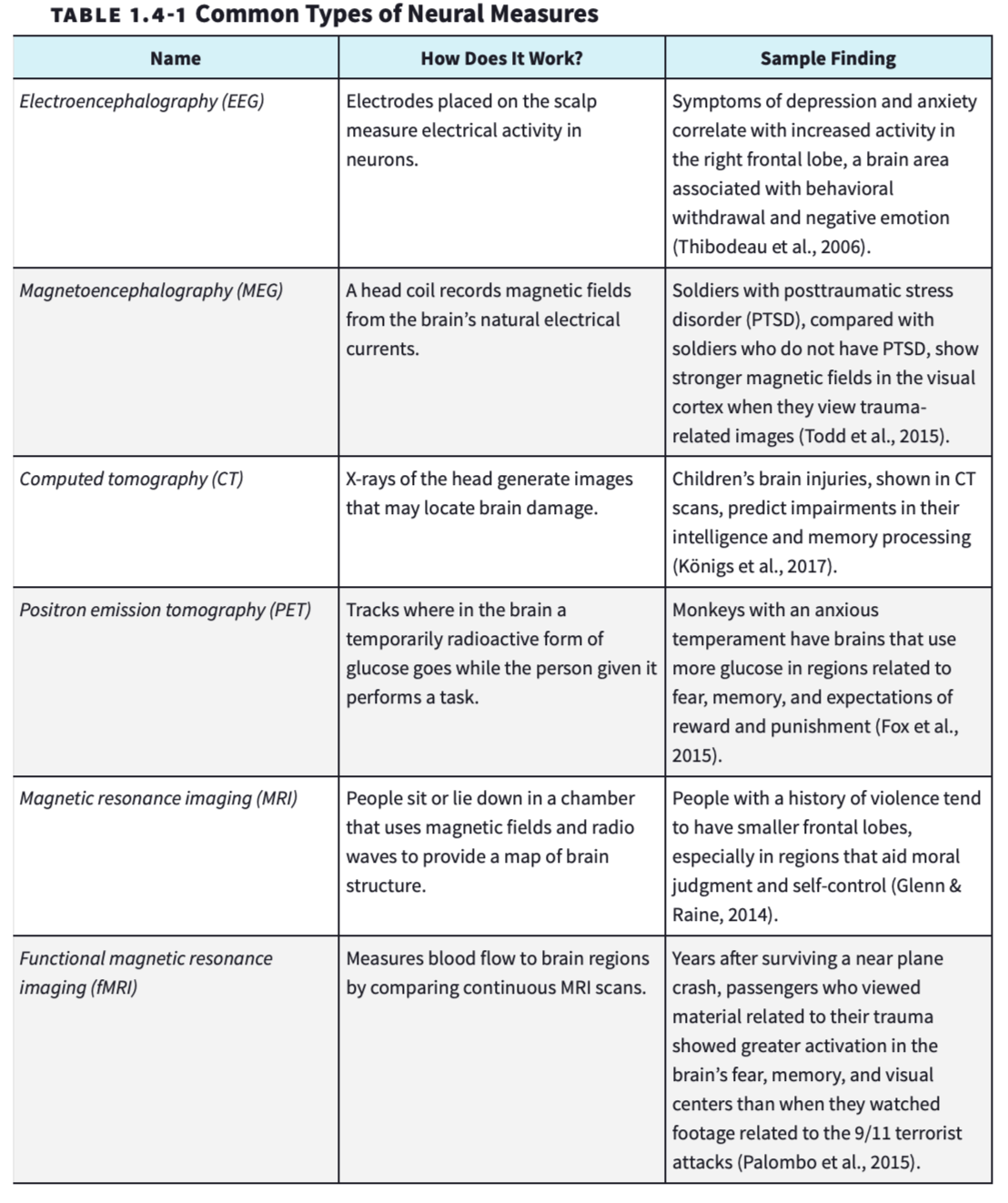
hindbrain - contains the medulla, ponds, and cerebellum; directs essential survival functions such as breathing, sleeping, and wakefulness, as well as coordination and balance.
midbrain - found atop the brainstem; connects hindbrain w/ forebrain involved in regulating movement and certain reflexes, and plays a role in auditory and visual processing.
forebrain - consists of the cerebral cortex, thalamus and hypothalamus; responsible for higher-order brain functions such as thought, emotion, and memory.
brainstem - central structure of the brain that connects the brain to the spinal cord, controlling essential survival functions such as heartbeat and breathing.
medulla - located in the hindbrain; regulates autonomic functions such as breathing, heart rate, and blood pressure.
thalamus - forebrain sensory control center; acts as the brain’s relay station, directing sensory info to appropriate areas of the cerebral cortex.
reticular formation - a nerve network that travels through the brain stem into the thalamus; filters info and plays important role in controlling arousal.
cerebellum - “little brain” situated at back of the brain; responsible for coordination, balance, and fine muscle control, and enabling nonverbal learning and memory
limbic system - neural system located mostly in the forebrain — below the cerebral hemispheres — that includes the amygdala, hypothalamus, hippocampus, thalamus, and pituitary gland; associated with emotions and drive.
amygdala - two lima-bean sized neural clusters in the limbic system; linked to emotion.
hypothalamus - a limbic system neural structure lying below (hypo) the thalamus; it directs several maintenance activities (eating, drinking, body temperature) helps govern the endocrine system, is linked to emotion and reward.
hippocampus - a neural center located in the limbic system; helps process explicit (conscious) memories — of facts and events — for storage.
cerebral cortex - the intricate fabric of interconnected neural cells that covers the cerebral hemispheres; the bodies ultimate control and information-processing center/
frontal lobes - located at the front of the brain; involved in reasoning, planning, problem-solving, emotional regulation, and movement.
parietal lobe - located at the top of the head; processes sensory info related to touch, temperature, and pain; involved in spatial orientation and body awareness.
occipital lobe - situated at the back of the head; primarily responsible for visual processing.
temporal lobe - located on the sides of the head above the ears; involved in processing auditory info, memory, and emotions
motor cortex - a cerebral cortex area at the rear of the frontal lobes that controls voluntary movements
somatosensory cortex - a cerebral cortex area at the front of the parietal lobe that registers and processes body touch and movement sensations.
association areas - areas of the cerebral cortex that are not involved in primary motor or sensory functions; they are involved in higher-mental functions such as learning, remembering, thinking and speaking.
neurogenesis - the formation of new neurons
corpus callosum - the large band of neural fibers connecting the two brain hemispheres and carrying messages between them.
split brain - a condition resulting from surgery that isolates the brains two hemispheres by cutting the fibers (mainly those of the corpus callosum) and connecting them
1.5: Sleep
consciousness - our subjective awareness of ourselves and our environment.
cognitive neuroscience - the interdisciplinary study of the brain activity linked w/ cognition
dual processing - the principle that info is simultaneously processed on separate conscious and unconscious tracks.
blindsight - a condition in which a person can respond to a visual stimulus w/o consciously experiencing it.
parallel processing - processing multiple aspects of a stimulus or problem simultaneously
sequential processing - processing one aspect of a stimulus or problem at a time; generally used to process new info or to solve difficult problems
sleep - a periodic, natural loss of consciousness — as distinct from unconsciousness resulting from a coma, general anesthesia, or hibernation
circadian rhythm - our biological clock; regular bodily rhythms (for ex, for wakefulness and temperature) that occur on a 24 hour cycle
REM (rapid eye movement sleep) - a recurring sleep stage during which vivid dreams commonly occur.
important for memory and dreaming
alpha waves - the relatively slow brain waves, of a relaxed, awake state.
NREM (non-rapid eye movement) - encompasses all sleep stages except for REM sleep.
hallucinations - false sensory experiences, such as seeing something in the absence of the external visual stimulus
hypnagogic sensations - bizarre experiences such as jerking or a feeling of falling or floating weightlessly, while transitioning to sleep. (also called hypnic sensations)
delta waves - the large slow brain waves associated with deep sleep.
suprachiasmatic nucleus (SCN) - a pair of cell clusters in the hypothalamus that controls circadian rhythm. in response to light the SCN adjusts melatonin production, thus modifying our feelings of sleepiness
insomnia - recurring problems with falling or staying asleep.
narcolepsy - sudden attacks of overwhelming sleepiness.
sleep apnea - stopping breathing repeatedly while sleeping
REM sleep behavior disorder - acting out the content of dreams while asleep, including vocalizing or motor behaviors such as kicking and punching.
dreams - a sequence of images, emotions, and thoughts passing through a sleeping persons mind
REM rebound - the tendency for REM sleep to increase following REM sleep deprivation.
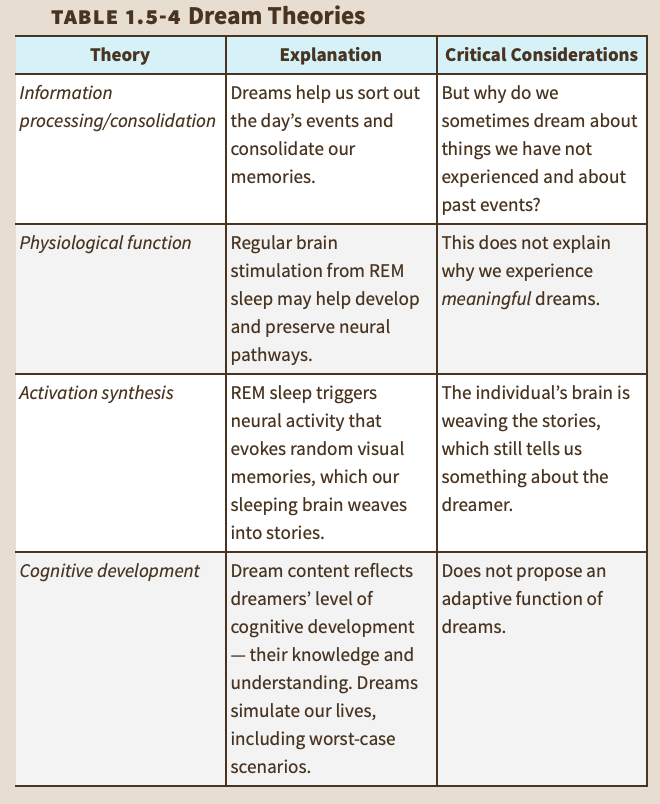
1.6: Sensation
sensation - the process by which our sensory receptors and nervous system receive and represent stimulus energies from our environment
sensory receptors - sensory nerve endings that respond to stimuli
perception - the process by which our brain organizes and interprets sensory info, enabling us to recognize objects and events as meaningful.
bottom-up processing - info processing that begins w/ the sensory receptors and works up to the brain’s integration of sensory info
top-down processing - info processing guided by higher-level mental processes, as when we construct perceptions drawing on our experience and expectations.
transduction - conversion of one form of energy into another. In sensation the transformation of physical energy such as sounds, sights, and smells into neural impulses the brain can interpret.
psychophysics - the study of the relationships between the physical characteristics of stimuli, such as their intensity, and our psychological experience of them.
absolute threshold - the minimum stimulus energy needed to detect a particular stimulus 50% of the time.
signal detection theory - a theory predicting how and when we detect the presence of a faint stimulus (signal) among background stimulation (noise). assumes there is no single absolute threshold and that detection depends partly on a person’s experience, expectations, motivation, and alertness.
subliminal - below one’s absolute threshold for conscious awareness.
difference threshold - the minimum difference b/n two stimuli required for detection 50% of the time. we experience this as a just noticeable difference (or jnd)
weber’s law - the principle that, to be perceived as different, two stimuli must differ by a constant minimum percentage (rather than a constant amount)
sensory adaptation - diminished sensitivity as a consequence of constant stimulation
wavelength - the distance from the peak of one light or sound wave to the peak of the next. Electromagnetic wavelengths vary from the short gamma waves to the long pulses of radio transmission.
hue - the dimension of color that is determined by the wavelength of light; what we know as the color names blue, green, and so forth.
intensity - the amount of energy in a light wave or sound wave, which influences what we perceive as brightness or loudness. Intensity is determined by the wave’s amplitude (height).
cornea - the eye’s clear, protective outer layer, covering the pupil and iris.
pupil - the adjustable opening in the center of the eye through which light enters.
iris - a ring of muscle tissue that forms the colored portion of the eye around the pupil and controls the size of the pupil opening.
lens. - the transparent structure behind the pupil that changes shape to help focus images on the retina.
retina - the light-sensitive back inner surface of the eye, containing the receptor rods and cones plus layers of neurons that begin the processing of visual information.
accommodation - (1) in sensation and perception, the process by which the eye’s lens changes shape to focus images of near or far objects on the retina. (2) in developmental psychology, adapting our current schemas (understandings) to incorporate new information.
rods - retinal receptors that detect black, white, and gray, and are sensitive to movement; necessary for peripheral and twilight vision, when cones don’t respond.
cones - retinal receptors that are concentrated near the center of the retina and that function in daylight or in well-lit conditions. Cones detect fine detail and give rise to color sensations.
optic nerve - the nerve that carries neural impulses from the eye to the brain.
fovea - the central focal point in the retina, around which the eye’s cones cluster.
Young–Helmholtz trichromatic (three-color) theory - the theory that the retina contains three different types of color receptors — one most sensitive to red, one to green, one to blue — which, when stimulated in combination, can produce the perception of any color.
opponent-process theory - the theory that opposing retinal processes (red-green, blue-yellow, white-black) enable color vision. For example, some cells are stimulated by green and inhibited by red; others are stimulated by red and inhibited by green.
feature detectors - nerve cells in the brain’s visual cortex that respond to specific features of the stimulus, such as shape, angle, or movement.
parallel processing - processing multiple aspects of a stimulus or problem simultaneously.
audition - the sense or act of hearing.
frequence - the number of complete wavelengths that pass a point in a given time (for example, per second).
pitch - a tone’s experienced highness or lowness; depends on frequency.
middle ear -the chamber between the eardrum and cochlea containing three tiny bones that concentrate the vibrations of the eardrum on the cochlea’s oval window.
cochlea - a coiled, bony, fluid-filled tube in the inner ear; sound waves traveling through the cochlear fluid trigger nerve impulses.
inner ear - the innermost part of the ear, containing the cochlea, semicircular canals, and vestibular sacs.
sensorineural hearing loss - the most common form of hearing loss, caused by damage to the cochlea’s receptor cells or to the auditory nerve; also called nerve deafness.
conduction hearing loss - a less common form of hearing loss, caused by damage to the mechanical system that conducts sound waves to the cochlea.
cochlear implant - a device for converting sounds into electrical signals and stimulating the auditory nerve through electrodes threaded into the cochlea.
place theory - in hearing, the theory that links the pitch we hear with the place where the cochlea’s membrane is stimulated. (Also called place coding.)
frequency theory - in hearing, the theory that the rate of nerve impulses traveling up the auditory nerve matches the frequency of a tone, thus enabling us to sense its pitch. (Also called temporal coding.)
gate-control theory - the theory that the spinal cord contains a neurological “gate” that blocks pain signals or allows them to pass on to the brain. The “gate” is opened by the activity of pain signals traveling up small nerve fibers and is closed by activity in larger fibers or by information coming from the brain.
gustation - our sense of taste.
olfaction - our sense of smell.
kinesthesis - our movement sense — our system for sensing the position and movement of individual body parts.
vestibular sense - our balance sense; our sense of body movement and position that enables our sense of balance.
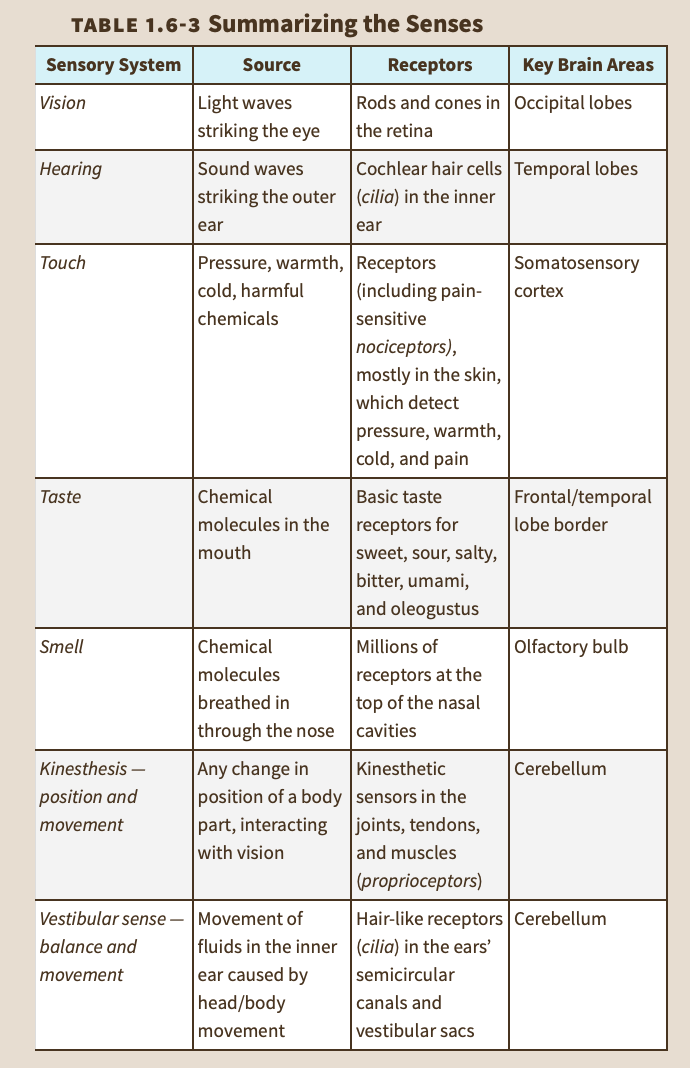
sensory interaction - the principle that one sense may influence another, as when the smell of food influences its taste.
embodied cognition - the influence of bodily sensations, gestures, and other states on cognitive preferences and judgments.